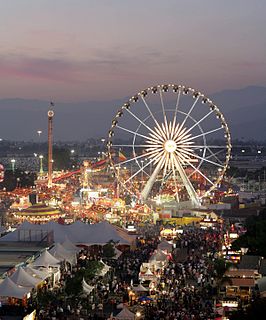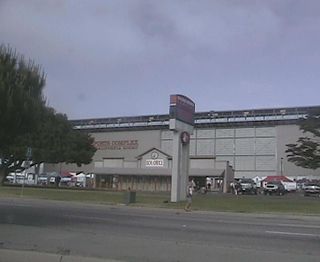
Executive Order 9066 was a United States presidential executive order signed and issued during World War II by United States president Franklin D. Roosevelt on February 19, 1942. This order authorized the secretary of war to prescribe certain areas as military zones, clearing the way for the incarceration of Japanese Americans, German Americans, and Italian Americans in U.S. concentration camps.

Manzanar is best known as the site of one of ten American concentration camps, where more than 120,000 Japanese Americans were incarcerated during World War II from December 1942 to 1945. Located at the foot of the Sierra Nevada in California's Owens Valley between the towns of Lone Pine to the south and Independence to the north, it is approximately 230 miles (370 km) north of Los Angeles. Manzanar was identified by the United States National Park Service as the best-preserved of the former camp sites, and is now the Manzanar National Historic Site, which preserves and interprets the legacy of Japanese American incarceration in the United States.

The internment of Japanese Americans in the United States during World War II was the forced relocation and incarceration in concentration camps in the western interior of the country of about 120,000 people of Japanese ancestry, most of whom lived on the Pacific Coast. Sixty-two percent of the internees were United States citizens. These actions were ordered by President Franklin D. Roosevelt shortly after Imperial Japan's attack on Pearl Harbor.

Santa Anita Park is a Thoroughbred racetrack in Arcadia, California, United States. It offers some of the prominent horse racing events in the United States during early fall, winter and in spring. The track is home to numerous prestigious races including both the Santa Anita Derby and the Santa Anita Handicap as well as hosting the Breeders' Cup in 1986, 1993, 2003, 2008, 2009, 2012, 2013, 2014, 2016 and 2019. Since 2011, The Stronach Group are the current owners.

The Heart Mountain War Relocation Center, named after nearby Heart Mountain and located midway between the towns of Cody and Powell in northwest Wyoming, was one of ten concentration camps used for the internment of Japanese Americans evicted from the West Coast Exclusion Zone during World War II by executive order from President Franklin Roosevelt after the bombing of Pearl Harbor in December 1941, upon the recommendation of Lieutenant General John L. DeWitt.

Camp Harmony was the unofficial euphemistic name of the Puyallup Assembly Center, a temporary facility within the system of internment camps set up for Japanese Americans during World War II. Approximately 7,390 Americans of Japanese descent from Western Washington and Alaska were sent to the camp before being transferred to the War Relocation Authority camps at Minidoka, Idaho, Tule Lake, California and Heart Mountain, Wyoming.

Fairplex, known prior to 1984 as the Los Angeles County Fairgrounds, has been the home of the L.A. County Fair since 1922. It is located in the city of Pomona, California. The L.A. County Fair is now held during the month of September, but the facility is used year-round to host a variety of educational, commercial, and entertainment such as trade and consumer shows, conventions, and sporting events.

The Topaz War Relocation Center, also known as the Central Utah Relocation Center (Topaz) and briefly as the Abraham Relocation Center, was an American concentration camp which housed Americans of Japanese descent and immigrants who had come to the United States from Japan, called Nikkei. President Franklin Roosevelt signed Executive Order 9066 in February 1942, ordering people of Japanese ancestry to be incarcerated in what were euphemistically called, "relocation centers" like Topaz during World War II. Most of the people incarcerated at Topaz came from the Tanforan Assembly Center and previously lived in the San Francisco Bay Area. The camp was opened in September 1942 and closed in October 1945.

Pinedale is a previously unincorporated community in Fresno County, California. It lies at an elevation of 348 feet. It was once a rural community located on the Southern Pacific Railroad 3.5 miles (5.6 km) north-northwest of Clovis but has since become surrounded and annexed by the city of Fresno. Millerton Lake State Recreational Area is to its NE. The ZIP Code is 93650, and the community is inside area code 559.

The Salinas Sports Complex is a sporting complex located in Salinas, California on the Central Coast. The main feature of the complex is a 17,000-seat stadium for California Rodeo Salinas. Soccer, football, and rugby was also played at the main stadium before the opening of Rabobank Stadium next door.

The Big Fresno Fair is the largest annual event in the Central Valley, attracting more than 600,000 people each October during its two-week run featuring exhibits, a livestock show, live horse racing, musical entertainment, educational programs and more. The Fair provides a link between urban and rural California, serving as a tool in educating Valley residents on the region's rich agricultural industry who might have otherwise not understood the importance or vastness of this commerce on the region. The mission of The Big Fresno Fair is to "Educate, Celebrate and Have Fun."

Propaganda for Japanese-American internment is a form of propaganda created between 1941 and 1944 within the United States that focused on the relocation of Japanese Americans from the West Coast to internment camps during World War II. Several types of media were used to reach the American people such as motion pictures and newspaper articles. The significance of this propaganda was to project the relocation of Japanese Americans as matter of national security, although according to a federal commission created by President Jimmy Carter in 1980:
The promulgation of Executive Order 9066 was not justified by military necessity, and the decisions that followed from it – detention, ending detention and ending exclusion – were not driven by analysis of military conditions. The broad historical causes which shaped these decisions were race prejudice, war hysteria and a failure of political leadership.
Togo W. Tanaka was an American newspaper journalist and editor who reported on the difficult conditions in the Manzanar internment camp, where he was one of 110,000 Japanese Americans who had been relocated after the Japanese attack on Pearl Harbor on December 7, 1941.

Rough and Ready Island Naval Supply Depot or Ruff and Ready Island is a former United States Navy installation on the San Joaquin River in Stockton, California in San Joaquin County, near the Stockton Channel and was 3 miles (4.8 km) west of Stockton. The Supply Depot was built during World War II as part of the San Joaquin Depot that operated the nearby Tracy Depot Facility and the Sharpe Depot Facility. The Rough and Ready Island Annex, which opened in 1944, operated as a supply Depot until 1959 when it became the Naval Communications Station for the Pacific Coast region. The Navy built the longest continuous concrete wharf, at 6,500 feet (2,000 m), able berth 13 ships in a line. The Depot Annex served the United States Pacific Fleet. The Depot warehoused naval stores, disposed of surplus Naval property and provided logistical support for other Naval bases. For some time the wharf was used to store as mothballed ships of the reserve fleet for the Pacific Reserve Fleet. The Naval Supply Depot was phased out of use as a result of special legislation sponsored by Senator Dianne Feinstein in 1995. It was transferred to the Port of Stockton between 2000 and 2003. This area of the port is now known as the "West Complex". Located at 37.953°N 121.32°W.

The Manzanar Children's Village was an orphanage for children of Japanese ancestry incarcerated during World War II as a result of Executive Order 9066, under which President Franklin Roosevelt authorized the forced removal of Japanese Americans from the West Coast of the United States. Contained within the Manzanar concentration camp in Owens Valley, California, it held a total of 101 orphans from June 1942 to September 1945.
Mitsuye Endo Tsutsumi was an American woman of Japanese descent who was placed in a internment camp during World War II. Endo filed a writ of habeus corpus that ultimately led to a United States Supreme Court ruling that the U.S. government could not continue to detain a citizen who was "concededly loyal" to the United States.

The Temporary Detention Camp for Japanese Americans / Pomona Assembly Center is one of the places Japanese Americans were held during World War 2. The Pomona Assembly Center was designated a California Historic Landmark on May 13, 1980. The Pomona Assembly Center is located in what is now called the Fairplex in Pomona, California in Los Angeles County. The Pomona Assembly Center was called Los Angeles County Fairgrounds in 1942.

California during World War II was a major contributor to the World War II effort. California's long Pacific Ocean coastline provided the support needed for the Pacific War. California also supported the war in Europe. After the Japanese attack on Pearl Harbor, Hawaii, on December 7, 1941 most of California was shifted to the war effort. California became a major ship builder and aircraft manufacturer. Existing military installations were enlarged and many new ones were built. California trained many of the troops before their oversea deployment. Over 800,000 Californians served in the United States Armed Forces. California agriculture, ranches and farms were used to feed the troops around the world. California's long coastline also put the state in fear, as an attack on California seemed likely. California was used for the temporary and permanent internment camps for Japanese Americans. The population of California grew significantly, largely due to servicemen who were stationed at the new military bases/training facilities and mass influx of workers from around the U.S. in the growing defense industries. With all the new economy activity, California was lifted out of the great depression. Over 500,000 peopled moved to California from other states to work in the growing economy. California expanded its oil and mineral production to keep up with the war demand.

The Santa Anita Ordnance Training Center also called Camp Santa Anita was training center built for World War 2. Santa Anita Ordnance Training Center Rifle Range was built is what is now the foothills of the San Gabriel Mountains, just north of East Pasadena, California. The 1029 acres camp, opened on November 30, 1942, was used for rifle and pistol training. Also at the range was small anti-aircraft range and an infiltration coarse, an type of obstacle course. The range closed in 1944 and the land lease ended in 1950. Most of troops trained at the range were based at the U.S. Army Ordnance Corps's Santa Anita Ordnance Training Center at the Santa Anita Racetrack in Arcadia, California in Los Angeles County. Before used as a training center the Santa Anita Racetrack was used for the Santa Anita assembly center a temporary internment camp for Japanese Americans from March 27 to October 27 of 1942. Camp Santa Anita was also used to hold German prisoner of war, held at the camp was several thousand of Erwin Rommel's Afrika Korps troops captured during the North African campaign. The Center had some Italian Service Units working at the depot.





















